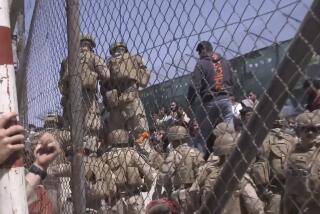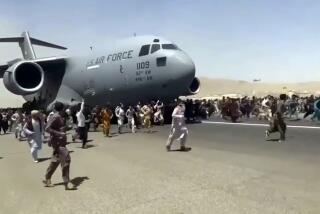Gen. McChrystal visits Afghanistan site of disputed NATO airstrike
The top U.S. commander in Afghanistan on Saturday visited the scene of a deadly NATO airstrike, a highly unusual gesture apparently meant to signal how seriously the alliance takes civilian casualties, which have been one of the most contentious issues in the war.
NATO has launched an investigation of Friday’s predawn strike on two hijacked fuel tankers in northern Afghanistan, which left dozens of people dead or injured. Local officials and relatives say many villagers were among the casualties, but it remained unclear how many of the estimated 70 dead were insurgents and how many were civilians.
Army Gen. Stanley A. McChrystal, who assumed command of all U.S. and other Western troops in Afghanistan three months ago, took swift damage-control measures.
The general flew to Kunduz province, near the border with Tajikistan, where he walked the muddy riverbank where the airstrike occurred, and then visited a hospital where some of the injured were being treated. Among those he spoke with was a 10-year-old boy who suffered burns, said journalists who traveled with McChrystal.
A visit by such a senior Western official is a rarity in the aftermath of an airstrike in which Afghan officials says civilians were hurt or killed.
Almost immediately after assuming command, McChrystal tightened the rules of engagement governing when airstrikes, which are responsible for nearly all civilian deaths inadvertently caused by Western forces, can be employed.
Whether those rules were followed in Friday’s incident is likely to be hotly debated. German troops, fearing that the stolen trucks could be used to stage suicide attacks on a nearby German base, called in the airstrike after the fuel tankers were hijacked Thursday evening by the Taliban. A U.S. fighter jet dropped two 500-pound bombs on the tankers, which ignited in a ball of flame, military officials said.
The United Nations mission in Afghanistan said it was launching its own investigation in an effort to determine not only how many civilians were killed or hurt but whether the strike was warranted.
Under the new rules, airstrikes may be used to prevent Western troops from being overrun, or in other cases of imminent danger. The mere presence of armed insurgents is not sufficient, according to McChrystal’s directive.
“Steps . . . must be taken to examine what happened, and why an airstrike was employed in circumstances where it was hard to determine with certainty that civilians were not present,” said Peter W. Galbraith, the deputy U.N. special representative in the country.
Local officials said that when villagers learned the trucks were stranded, they rushed to try to siphon fuel or simply to gawk, and were caught up in the fiery strike. Even though it was the middle of the night, most people were awake because it is Ramadan, when observant Muslims fast between dawn and dusk, then have lavish meals at night.
Villager Abdullah Hanan, who brought an injured cousin to Kabul, the Afghan capital, for treatment, described “fire and smoke in the sky and the bodies of people everywhere.”
He said another cousin had been killed, and that another of his relatives was hospitalized with burns so severe that doctors had told the family he would almost certainly die. The corpses of those who were closest to the fireball were incinerated, which will make it difficult to determine whether they were fighters or villagers.
“I blame Taliban and Americans both,” Hanan said. “First the Taliban, who caused this incident, and then Americans, who dropped bombs to kill people.”
--
Faiez is a special correspondent.
More to Read
Sign up for Essential California
The most important California stories and recommendations in your inbox every morning.
You may occasionally receive promotional content from the Los Angeles Times.





